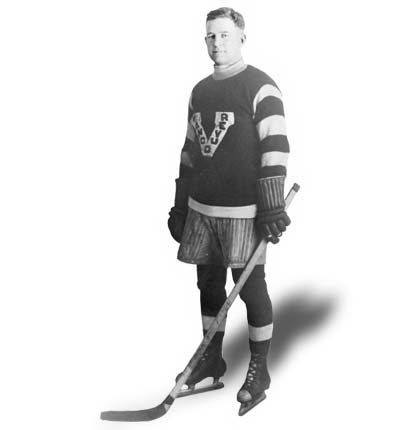Jack Adams (Jack Adams)

Born in Fort William, Ontario, Adams began his career with the Fort William Maple Leafs in 1914 of the NMHL, and played for the Calumet Miners a year later. In 1916, he joined the intermediate Peterborough 247th Battalion of the Ontario Hockey Association and the next season moved up to the senior Sarnia Sailors. His brother, Bill also was a professional hockey player. Adams turned pro in 1917 upon joining the Torontos of the NHL, earning the reputation as a physical, bruising player. Although he participated in the NHL playoffs, he did not play in any games in the 1918 Stanley Cup Finals against the Vancouver Millionaires when the Torontos won the trophy. In December 1919, he was lured west to join the Millionaires, where he flourished as a player, leading the league in scoring in 1921–22, when he centred a line with Alf Skinner and Smokey Harris. He played in two Stanley Cup series for Vancouver, and was the star of the 1922 series, scoring 6 goals in 5 games.
Coming off that season, he returned east to join the Toronto St. Patricks and played four seasons in Toronto on a line with Babe Dye. Adams was the team’s leading scorer in 1925–26. The next season, he joined the Ottawa Senators, finishing his playing career as it began, with a second Stanley Cup championship. His NHL stats included 83 goals, 32 assists in 173 games played. Adams was inducted into the Hockey Hall of Fame in 1959 as a player.
Soon after his retirement, he became coach and general manager of the second-year Detroit Cougars at the suggestion of NHL president Frank Calder.
At first, the team struggled under his leadership, making the playoffs only two times in his first five years at the helm. A name change to the Detroit Falcons in 1930 did not improve the team’s performance. Detroit’s fortunes changed in 1932, when Chicago grain merchant James E. Norris bought the Falcons and renamed them the Detroit Red Wings. Norris gave the Red Wings the financing they needed to become an NHL power. Adams led the team to three Stanley Cups before stepping down in 1947 to concentrate on his duties as general manager. His coaching career tallied 413 wins, 390 losses and 161 ties, including a 52–52–1 coaching record in the playoffs. Most of those wins came without a contract; when Norris bought the team he’d torn up Adams’ contract and given him a year on his job on probation and a handshake. As it turned out, one year became 15 years. Adams is the second-most winningest coach in Red Wings history, behind current head coach Mike Babcock.
By 1947, Adams had built a farm team system which trained Alex Delvecchio, Terry Sawchuk, Ted Lindsay, Red Kelly, Sid Abel, and most notably Gordie Howe. It was this core group of players which led the Red Wings to seven straight regular season first-place finishes from 1948 to 1955, along with four more Cups—making Adams the only man to have his name on the Stanley Cup as a player, coach and general manager.
Adams was known for being wary of letting his teams get complacent, and was not shy about orchestrating blockbuster trades to keep them on their toes—a philosophy which won him the nickname “Trader Jack.” His implulse was slightly restrained after Norris died in 1952 and was succeeded by his daughter, Marguerite Norris. She and Adams never got along very well. While she could have summarily fired Adams since he was still without a contract, she did not do so. However, Marguerite was forced to turn over control of the team to her younger brother, Bruce Norris, in 1955 after losing an intrafamily struggle. Bruce voiced full confidence in Adams, and the trading resumed anew. During their seven-season run in first place, many thought the Red Wings would rule the league for years to come.
In 1957, Adams traded Ted Lindsay to Chicago because of union-organizing efforts and other players affiliated with the effort being sent to the minors. As part of the union busting efforts, Adams spread fake rumours attributing Lindsay as criticizing his former team-mates. Adams also showed a fake contract to Detroit reporters, claiming Lindsay was being paid $25,000 per year, when he was being paid $13,000. These efforts are dramatized in the TV movie Net Worth. The efforts resulted in most of the core of this team leaving town and eventually led to Adams being fired in 1963. His 36-year tenure as general manager is the longest in NHL history. He served 31 of those years on a handshake; after 1932 he never signed a contract with the Wings.
Adams had also been involved in an incident in 1942, when he had an outburst due to his belief of biased penalty calling, which led to a fit of rage and ultimately a referee getting punched in game three of the 1942 Stanley Cup Final, becoming the first coach to be suspended in a Final. In 1963, Adams became founding president of the Central Hockey League, a post he held until his death at his desk in 1968.
Born
- July, 14, 1895
- Canada
- Fort William, Ontario
Died
- May, 01, 1968
- USA
- Detroit, Michigan
Cemetery
- White Chapel Memorial Park Cemetery
- Troy, Michigan
- USA


